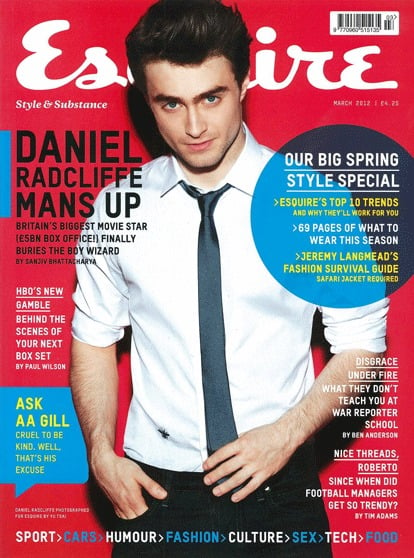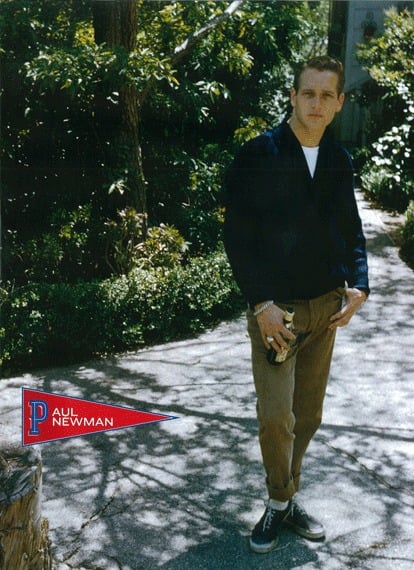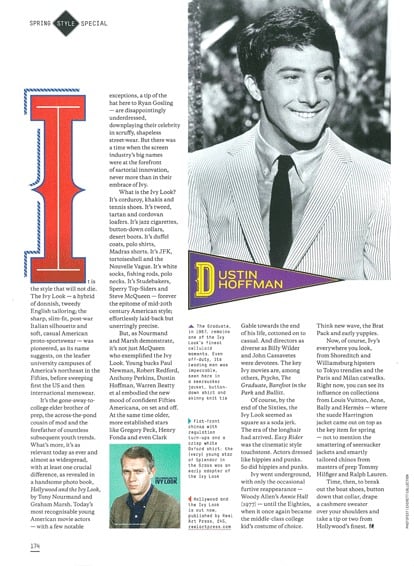Esquire
Hollywood Goes To College
It is the style that will not die. The Ivy Look – a hybrid of donnish, tweedy English tailoring; the sharp, slim-fit, post-war Italian silhouette and soft, casual American proto-sportswear – was pioneered, as its name suggests, on the leafier university campuses of America’s northeast in the Fifties, before sweeping first the US and then international menswear.
It’s the gone-away-to-college elder brother of prep, the across-the-pond cousin of mod and the forefather of countless subsequent youth trends. What’s more, it’s as relevant today as ever and almost as widespread, with at least one crucial difference, as revealed in a handsome photo book, Hollywood and the Ivy Look, by Tony Nourmand and Graham Marsh. Today’s most recognizable young American movie actors – with a few notable exceptions, a tip of the hat here to Ryan Gosling – are disappointingly underdressed, downplaying their celebrity in scruffy, shapeless street-wear. But there was a time when the screen industry’s big names were at the forefront of sartorial innovation, never more than in their embrace of Ivy
What is the Ivy Look? It’s corduroy, khakis and tennis shoes. It’s tweed, tartan and cordovan loafers. It’s jazz cigarettes, button-down collars, desert boots. It’s duffel coats, polo shirts, Madras shorts. It’s JFK, tortoiseshell and the Nouvelle Vague. It’s white socks, fishing rods, polo necks. It’s Studebakers, Sperry Top-Siders and Steve McQueen – forever the epitome of mid-20th century American style; effortlessly laid-back but unerringly precise.
But, as Nourmand and Marsh demonstrate, it’s not just McQueen who exemplified the Ivy Look. Young bucks Paul Newman, Robert Redford, Anthony Perkins, Dustin Hoffman, Warren Beatty et al embodied the new mood of confident Fifties Americana, on set and off. At the same time older, more established stars like Gregory Peck, Henry Fonda and even Clark Gable towards the end of his life, cottoned on to casual. And directors as diverse as Billy Wilder and John Cassavetes were devotees. The key Ivy movies are, among others, Psycho, The Graduate, Barefoot in the Park and Bullitt.
Of course, by the end of the Sixties, the Ivy Look seemed as square as a soda jerk. The era of the longhair had arrived. Easy Rider was the cinematic style touchstone. Actors dressed like hippies and punks. So did hippies and punks,.
Ivy went underground, with only the occasional furtive reappearance – Woody Allen’s Annie Hall (1977) – until the Eighties, when it once again became the middle-class college kid’s costume of choice. Think new wave, the Brat Pack and early yuppies.
Now, of course, Ivy’s everywhere you look, from Shoreditch and Williamsburg hipsters to Toyko trendies and the Paris and Milan catwalks. Right now, you can see its influence on collections from Louis Vuitton, Acne, Bally and Hermès – where the suede Harrington jacket came out on top as the key item for spring – not to mention the smattering of seersucker jackets and smartly tailored chinos from masters of prep Tommy Hilfiger and Ralph Lauren.
Time, then, to break out the boat shoes, button down that collar, drape a cashmere sweater over your shoulders and take a tip or two from Hollywood’s finest.











